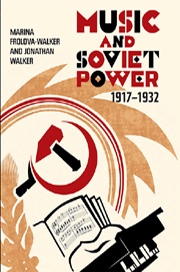Book contents
- Frontmatter
- Contents
- Preface
- Acknowledgements
- Note on transliteration
- Chronology of Political and Musical Events
- October 1917–18: Out of Chaos
- 1919: Depression and Fever
- 1920: Bureaucracy on the Rise
- 1921: Should I stay or should I go?
- 1922: Just Like the Old Days?
- 1923: The Birth of ASM and RAPM
- 1924: ASM in the Ascendant
- 1925: Equilibrium
- 1926: Guests from the West
- 1927: Celebrations
- 1928: At the Crossroads
- 1929: Velikiy perelom – The Great Turning Point
- 1930: RAPM's Glorious Year?
- 1931: RAPM's Fortunes Turning
- 1932: The Rules Change
- Key to Acronyms and Institutional Bodies
- Glossary of Names
- Bibliography
- Index
1932: The Rules Change
Published online by Cambridge University Press: 05 April 2013
- Frontmatter
- Contents
- Preface
- Acknowledgements
- Note on transliteration
- Chronology of Political and Musical Events
- October 1917–18: Out of Chaos
- 1919: Depression and Fever
- 1920: Bureaucracy on the Rise
- 1921: Should I stay or should I go?
- 1922: Just Like the Old Days?
- 1923: The Birth of ASM and RAPM
- 1924: ASM in the Ascendant
- 1925: Equilibrium
- 1926: Guests from the West
- 1927: Celebrations
- 1928: At the Crossroads
- 1929: Velikiy perelom – The Great Turning Point
- 1930: RAPM's Glorious Year?
- 1931: RAPM's Fortunes Turning
- 1932: The Rules Change
- Key to Acronyms and Institutional Bodies
- Glossary of Names
- Bibliography
- Index
Summary
‘How did it happen that the whole of RAPM was left standing alone, while everyone else turned to Comrade Stalin for protection?’ This was the question thrown at members of RAPM, who had been called to attend a special closed session of the Narkompros Collegium on 26 February 1932. What brought RAPM to this point was the so-called ‘Gnesin affair’, when a fight with Vseroskomdram peaked in an open and bitter confrontation with one man who would not retreat – the composer and Conservatoire professor Mikhail Gnesin. A man of strong views, Gnesin retained his independence and refrained from aligning himself with any group during the 1920s. In 1928, for example, we find him opposing Goldenweiser and taking the side of Pedfak (he became its Dean). But later he fought against Rabfak, which had caused a lowering of standards that dismayed him. During the previous year, he had been involved in several highly publicised events. The first was a discussion of his own music at a Conservatoire ‘production meeting’, where he made an unguarded comment:
[I] once had the opportunity to play my part in the life of a particular peasant who is now a well-known writer, Chapygin. I could hold him in great affection, I could assist him in his work, learn from him and also teach him some things, but I have always felt that next to him I am a complex man, that my thoughts and feelings were more complex, and his were simpler.
- Type
- Chapter
- Information
- Music and Soviet Power, 1917–1932 , pp. 314 - 340Publisher: Boydell & BrewerPrint publication year: 2012



